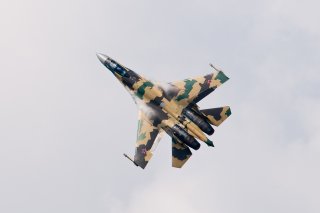Video Alert: The Russian Air Force Is Showing Off Its Deadly Su-35 Fighter
Could it be a big deal?
While prolonged aerial refueling footage is hardly exciting from a military hardware viewpoint, a series of videos demonstrating the Su-57 as a viable, near-finished product can prove useful as part of a larger Russian campaign to woo prospective investors.
Footage recently released by the Russian Ministry of Defense shows Russia's flagship fifth-generation stealth fighter, the Su-57, being aerially refueled by an Il-78 tanker. Before this, the Su-57 can be seen imitating a refueling formation behind an An-12 transport aircraft.
(This first appeared last month.)
Aerial refueling is a common feature of fifth-generation fighters, employed—though not without recurring issues—on America’s F-35 and now recently confirmed on China’s J-20. Also possible with some leading fourth-generation aircraft including the Su-35 and even the aging F-15, aerial refueling is best seen not as an added boon but as a necessity for the kinds of long-range operations that most jet fighters are meant to support.
As former F/A-18 pilot Rolf Siegel put it: “The main reason military aircraft use aerial refueling is to extend the mission radius of the jet.” He explains that “for long-range missions, a fighter will take off from their operating base, meet a tanker en-route to top-off, enter enemy territory to perform their mission, and then return back to the tanker to refuel again prior to flying back to land at their operating base.”
Why, then, would Russia’s Defense Ministry release footage of the Su-57 demonstrating a relatively mundane feature that it was always expected to have?
The Su-57’s refueling probe has been altered from the Su-35 to minimize failure rates, but this is only an iterative change with little significance in of itself. Rather, this and similar updates serve to push back against a flurry of rumors over the Su-57’s ongoing production troubles after India backed out of a joint Su-57 production program with Russia in April 2018.
The Saturn Al-41 engine currently used with the Su-57 is meant to be a midway point to the eventual implementation of the more powerful Saturn Izdeliye 30, but it remains to be seen whether the Izdeliye 30 can be mass-produced by Saturn’s estimate of 2019 at acceptable quality control levels. Others have argued that many of the Su-57’s advancements in maneuverability and weapons delivery systems are being cannibalized by the markedly less expensive late-fourth generation Su-35S Flanker-E that also uses the Al-41 engine.
The Su-57 was deployed in Syria in as part of a brief performance test; whether this involved combat scenarios of any kind remains unknown. This brevity can potentially be explained by the Russian concern that prolonged deployment would give adversaries that much more time to probe the Su-57’s design at a critical stage in its development.
This video and others like it are part of a multi-part documentary airing on the official channel of the Russian Ministry of Defense, Zvezda, reaffirming Russia’s commitment to the Su-57 project in light of technical and financial obstacles over the past few years.
The Kremlin could also be re-pitching the Su-57 project to India on the heels of the diplomatic goodwill generated by Moscow’s recent $5.43 billion sale of S-400 systems, frigates, and a leased nuclear submarine to New Delhi. Moscow wants to re-establish crucial Indian investments as the latest iteration of the Su-57 inches ever closer to mass-production readiness. The assertion of Chief Scientist Andrei Lagarkov that they minimized the Su-57’s radar cross-section footprint without compromising its “structural strength” is especially relevant to bringing India around to the Su-57, since New Delhi’s concerns over the state of the Su-57’s stealth capabilities were a major reason for their withdrawal.
While prolonged aerial refueling footage is hardly exciting from a military hardware viewpoint, a series of videos demonstrating the Su-57 as a viable, near-finished product can prove useful as part of a larger Russian campaign to woo prospective investors.
Mark Episkopos is a frequent contributor to The National Interest and serves as a research assistant at the Center for the National Interest. Mark is also a Ph.D. student in History at American University.
Image: Creative Commons.


